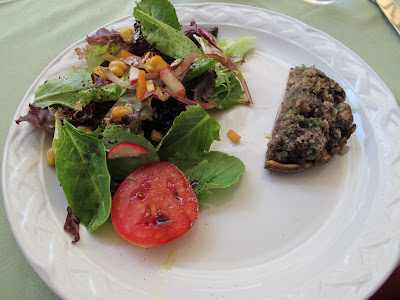It was day six of my Artisan & Architecture tour and we had just finished a scrumptious breakfast at the hotel. We were all packed and ready to head back to San Miguel de Allende. But we were not going directly back to San Miguel, we had a full day ahead of us. Out first stop was in Tzintzuntzan. The vendors in the market were just starting to open their stalls. The market is jam packed with straw decorations, baskets, purses, you name it, if something is made out of wicker, reeds or straw, you will find it here. The green glazed pineapples, pinas, from Patamban can also be found in a few of the stalls.
After we had checked out all the stalls, we walked over to the large courtyard that houses a monastery dating back to the 1500's, the La Soledad church and the Open Chapel of the Hospital dating back to 1619. The courtyard has quite a few very old olive trees that were planted by Don Vasco de Quiroga in the late 1500's. It must have been a miracle that these trees were not destroyed by the Spaniards. After the Spaniards brought the olive trees to the new world, it was later decided that Mexican olive oil would be in direct competition with Spain's. An edict was declared to destroy all olive trees in Mexico.
 On this particular day, we we lucky. We found the maestro Manuel Morales in his workshop, taller, which is in the large courtyard next to the open Chapel.
On this particular day, we we lucky. We found the maestro Manuel Morales in his workshop, taller, which is in the large courtyard next to the open Chapel.
His contemporary pottery has such beautiful, brilliant glazes on them.
His palette ranges from blue, browns and blacks. I could have bought ever piece in his taller.
Next stop in town was to the home and taller of Consuelo Pena.
These glazed plates and bowls show common area motifs of men fishing with butterfly nets, animals, woman selling fish, scenes of everyday life in the village...
I just love how this photo captured the love this grandpa, Consuelo's husband, had for his precious granddaughter.
Not far from Tzintzuntzan, we stopped in the town of Santa Fe La Laguna. Check my blog on Monday and I will tell you more about this special town. In the mean time, meet Nicholas Fabian, another very talented ceramist.
It is amazing that in such a rather small area that these ceramist techniques and styles are so vastly different. Again, I could have bought, bought and bought.
Nicolas's home was neat and tidy and my group was very intrigued with his kitchen. I bet some great meals come out of here. There was a pot of beans simmering on the stove that smelled really good. And talking about food, next stop was to the small village of El Tigre to one of my favorite places for lunch.
We had covered a lot of ground, met some talented artisans, seen some beautiful old architecture and I still had one very special stop in store for my group after lunch. Check my blog out next week and see where we went next.
Buena viaje!





















































